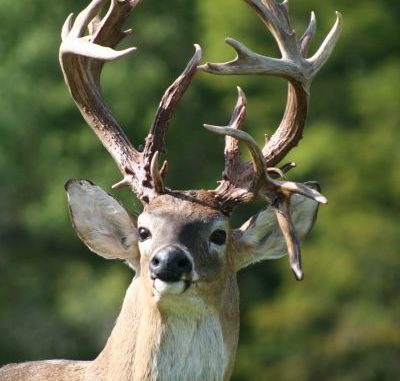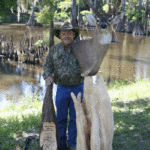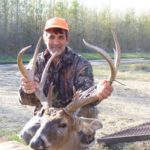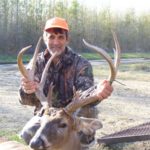
This 54-year-old bowhunter’s lifetime of chasing Tensas National Wildlife Refuge bucks led to a state-record archery buck last season. And his approach isn’t very complicated.
It was Jan. 7 of this year and Alton “Tadpole” McLeod was hunting an area of Tensas National Wildlife Refuge he had not previously hunted. He found a deer trail and a suitable tree for his climbing stand overlooking the trail and got set up.
Around 4 p.m. buzzards (of all things) began to congregate at a roost tree nearby.
“They were making a lot of noise, landing, flapping wings and breaking branches,” McLeod said. “There must have been 30 or 40 of them.”
Tadpole was discouraged and did not expect any deer movement due to all the noise. He considered moving, but since it was so late in the day he decided to sit it out till dark.
Around 5 p.m. he heard something moving in the palmettos, coming from the direction of the buzzard roost. He suspected either a deer or bear.
Getting to his feet in the stand and looking to his left at a distance of about 25 yards, Tadpole caught a glimpse of antler.
“All right! A buck!” the 54-year-old bow hunter thought.
The deer was hidden by a tree and seemed to be making a scrape. The buck then walked through a thicket and came into the clear at a distance of 15 to 18 yards, directly facing McLeod.
At this point a lifetime of hunting experience paid off. The buck was standing head down, looking to the left and right. McLeod was at full draw waiting for the buck to turn.
“I did not look at the antlers,” McLeod said. “This is when you stay focused on the pin and the shoulder.”
But the buck would not turn, and Tadpole knew he would have to make the shot soon.
So he placed the pin on the buck’s backbone, directly between the shoulders and released.
The shot was dead on and his Muzzy Broadhead did its job. The buck fell in his tracks.
McLeod’s first thought was gratitude.
“Thanks, Lord, for letting me kill another buck with the bow,” he thought.
He soon climbed down from the stand and approached the downed deer, still not knowing the size of the buck.
McLeod first noticed the drop tine and then began to count points. His excitement grew as the count approached 20.
While he, his son Derek, and longtime hunting partners Jude Moreau and John Berry were getting the deer out of the woods, he placed a phone call to hunting buddy Kenny Wallace at Hunter’s Bend Campground.
Tadpole told Kenny he had a 20-point buck. By the time they arrived at the campground a large crowd had gathered. The news of such a deer had travelled fast.
The deer wasn’t just your run-of-the-mill 20-point — it was later officially scored at 206 5/8 inches Pope & Young, topping the state’s Big Game Records’ archery category.
The words “New State Record Non-Typical Buck” grab every deer hunter’s attention, but when one actually lays eyes on Tadpole McLeod’s Tensas River National Wildlife Refuge buck, you are just, well, stunned.
Not only because this is a truly exceptional deer, but because this deer was taken with a bow and on public land.
McLeod remains as enthusiastic about hunting, especially at Tensas NWR, as when he started many years ago.
He is a life-long bow hunter who has consistently harvested deer year after year. He has hunted Lake Ophelia NWR, along with Big Lake and Buckhorn Wildlife Management Areas, but the majority of his time is spent on Tensas.
His love affair with Tensas began 25 years ago when he and two friends went to the refuge for the first time. They pitched a tent and took a mid-day ride around the refuge.
“We saw a lot of deer on that ride, and when you were on a stand you would see 10 or 12 deer in a day,” McLeod said.
He soon purchased a camp house for more comfortable accommodations and kept it for 15 years, sold it to a friend and recently bought it back.
In the last six or seven years Tadpole has taken several good bucks on Tensas, including two 8-points, some 6-points and in December of 2010 a 9-point scoring 103 inches.
The 9-pointer shows up at the bottom of the Louisiana Archery Records list. So he now holds the top and bottom spots in the listings, an irony not lost on Tadpole.
He figures there are still plenty of spots to fill in between.
McLeod will be back in Tensas hunting the rut this season with Derek, Moreau and Berry. The four have been hunting together for 15 years, and the now-30-year-old Derek took his first deer with a bow on Tensas at the age of 12.
The elder McLeod said the father/son hunting competition is always fun and has gone from him always taking more deer per season, to a neck and neck score, to Derek finally outdoing his dad at times.
No easy task, and Derek joked that his dad could climb a light pole in a Wal-Mart parking lot and kill a deer.
“He has that kind of luck,” Derek said with a chuckle.
Derek remembered his first bow-killed deer clearly, and said he shot all his arrows at this doe with a death wish.
He climbed down from the stand retrieved one of his fired arrows, climbed back up and took another shot, finally connecting.
He also remembered rising at 3 a.m. to walk the muddy trails to remote stand locations, but still calls it a great childhood, with many Christmases spent at the camp.
Moreau and Berry agreed, and both prefer to hunt Tensas during the rut in the days right after Christmas.
Moreau explained that, once they find a new area to hunt in the refuge, it usually takes a couple of years to refine stand locations for the precision needed for bow hunting.
He said staying mobile is important and does not worry too much about accidently bumping deer from feeding and bedding areas.
“The deer are not as pressured in Tensas,” he said “and are a little more forgiving.”
Berry said he looks forward to a good season this year, although he admits to never having a bad one in Tensas. He sees lots of deer activity, including bucks breeding does and other deer behaviors and vocalizations he had only read about before hunting Tensas.
He was recovering from an ankle injury late this summer, and was hoping to be able to walk well this season.
“There’s lots of room, and you can get away from people if you don’t mind walking,” Berry said.
All four members of the “Tadpole Team” agree Tensas is special. The size of the refuge, variety of wildlife and a chance at a truly great buck make it worth the effort it takes to hunt this bottomland.
Scouting for Tadpole McLeod starts in mid-September, when trails open on the refuge.
“We go up, clean and prepare the camp and start looking around, checking for acorns and persimmons,” he said.
He usually waits until the rut to begin hunting.
The foursome said they felt good about this season, and were selecting stand locations around the increasing number of “grass patches,” as Tadpole calls them. He believes the grassy areas are providing better cover and are helping deer tremendously.
McLeod hunts the rut with special attention to the moon phase.
“When the moon is full, I may not go to the stand until around 10 in the morning and sit until dark,” he said. “I concentrate on evenings then.”
McLeod said bow hunting is all about the details, and that includes familiarity with his equipment.
“I have learned three things from my bow shooting and hunting: You need to be comfortable with your bow, and the quietness and accuracy of the bow are more important to me than how fast it shoots,” he said.
Interestingly, he does not spend a great deal of time throughout the year practicing. He picks up the bow about a week before the season begins and takes a few shots. If the bow is sighted in and he is hitting well, he follows up with 10 to 15 shots per day until time to go hunting.
With so many years of successful archery hunting to his credit and two spots in the records book — one of those being the top spot — when Tadpole McLeod talks deer, people listen.
He points out the Tensas rut takes place in late December/early January. That can make for tough hunting conditions in inclement weather, and Tadpole admits to “lots of hard hunting and fighting the mud.”
But the Tensas River bottomland is the stuff of legends in Louisiana, particularly where big deer are concerned.
I wonder McLeod will be placing any stands near buzzard roosts this year?




